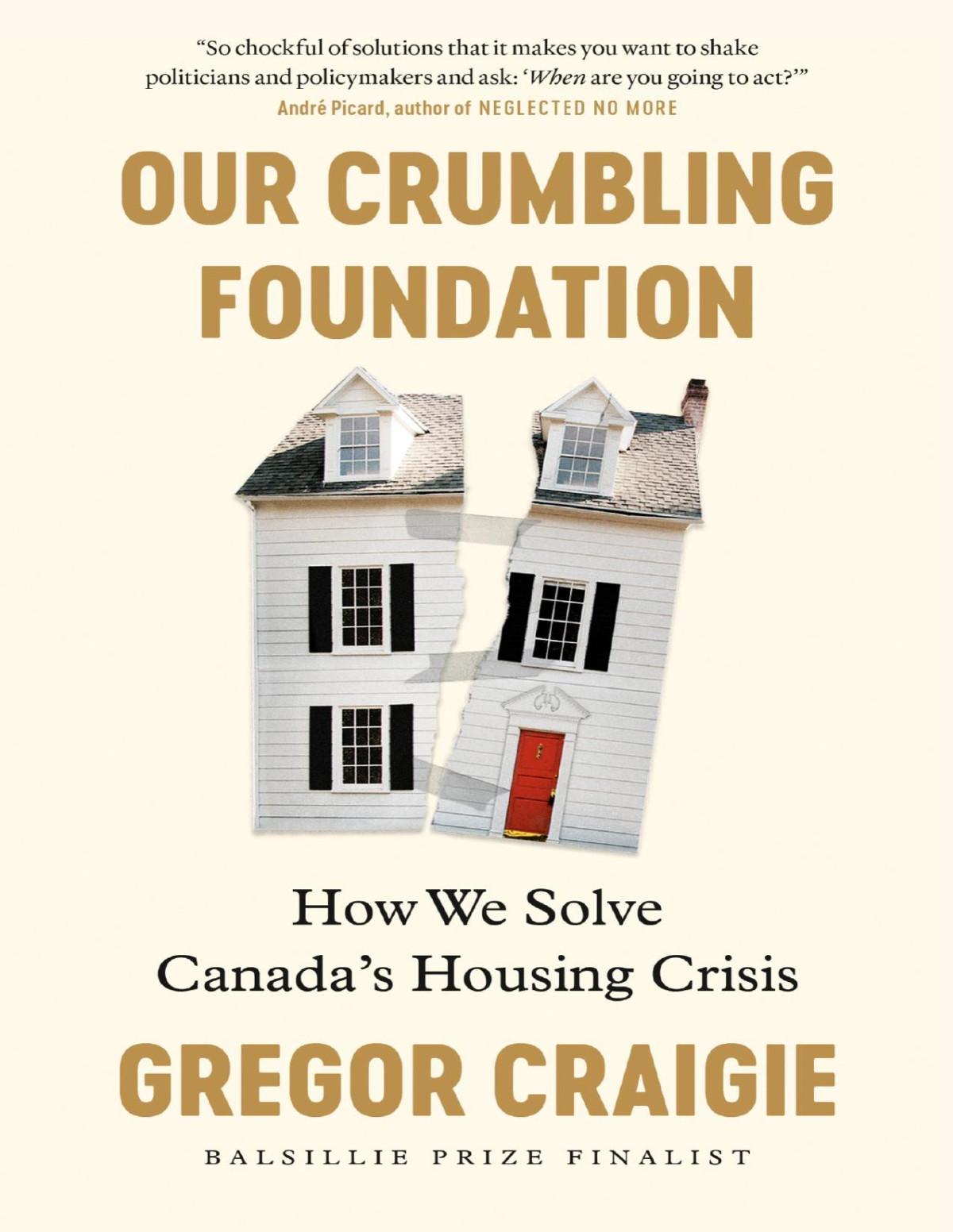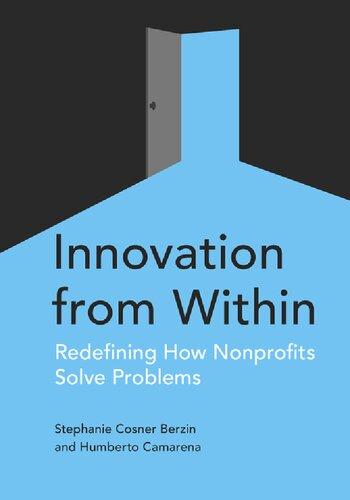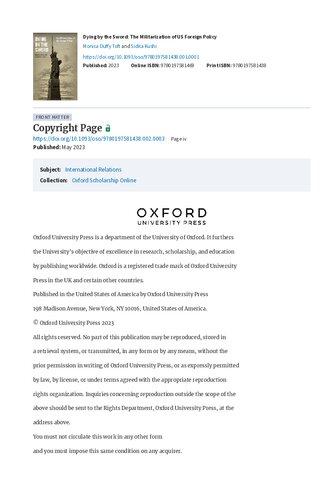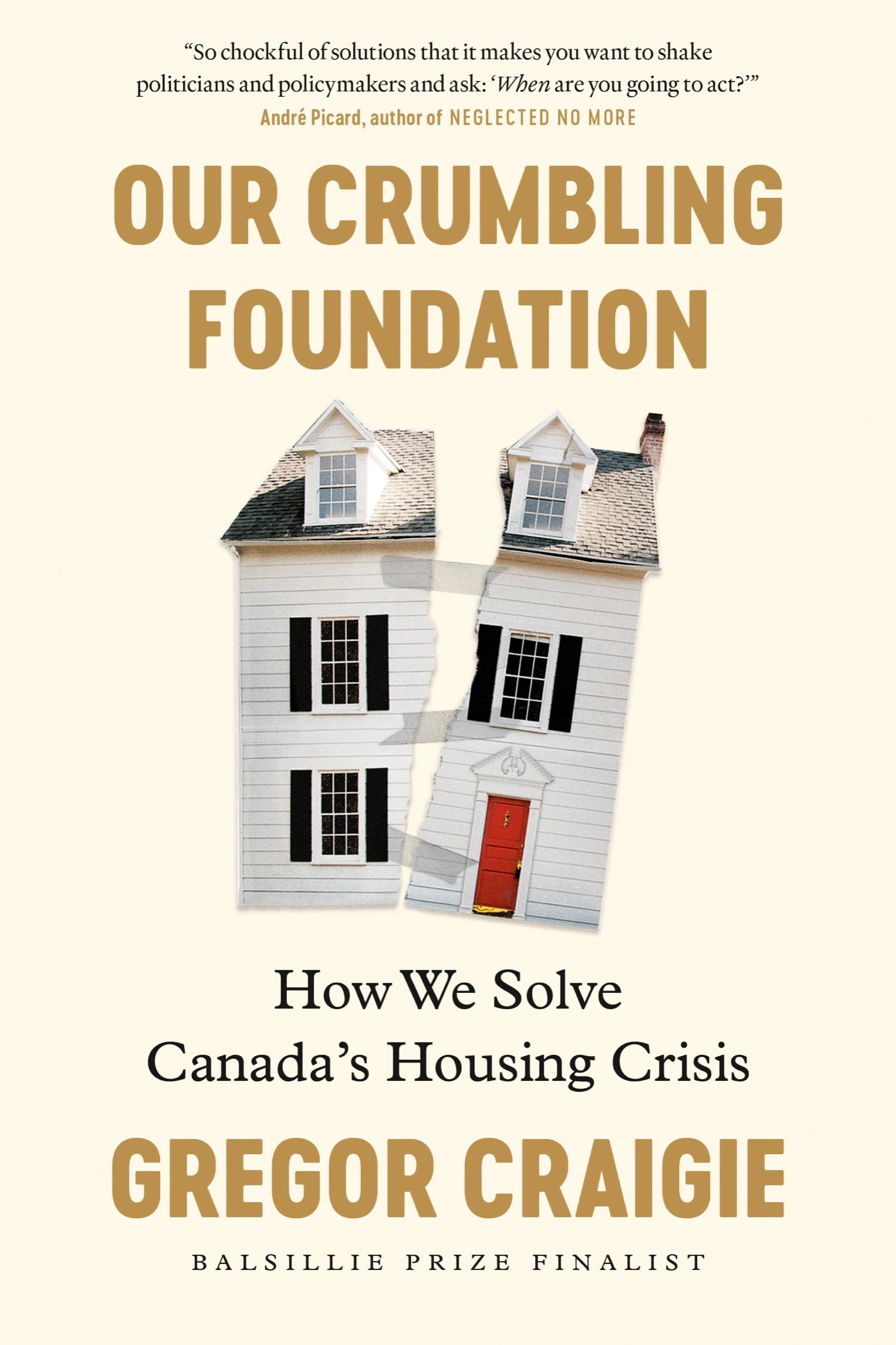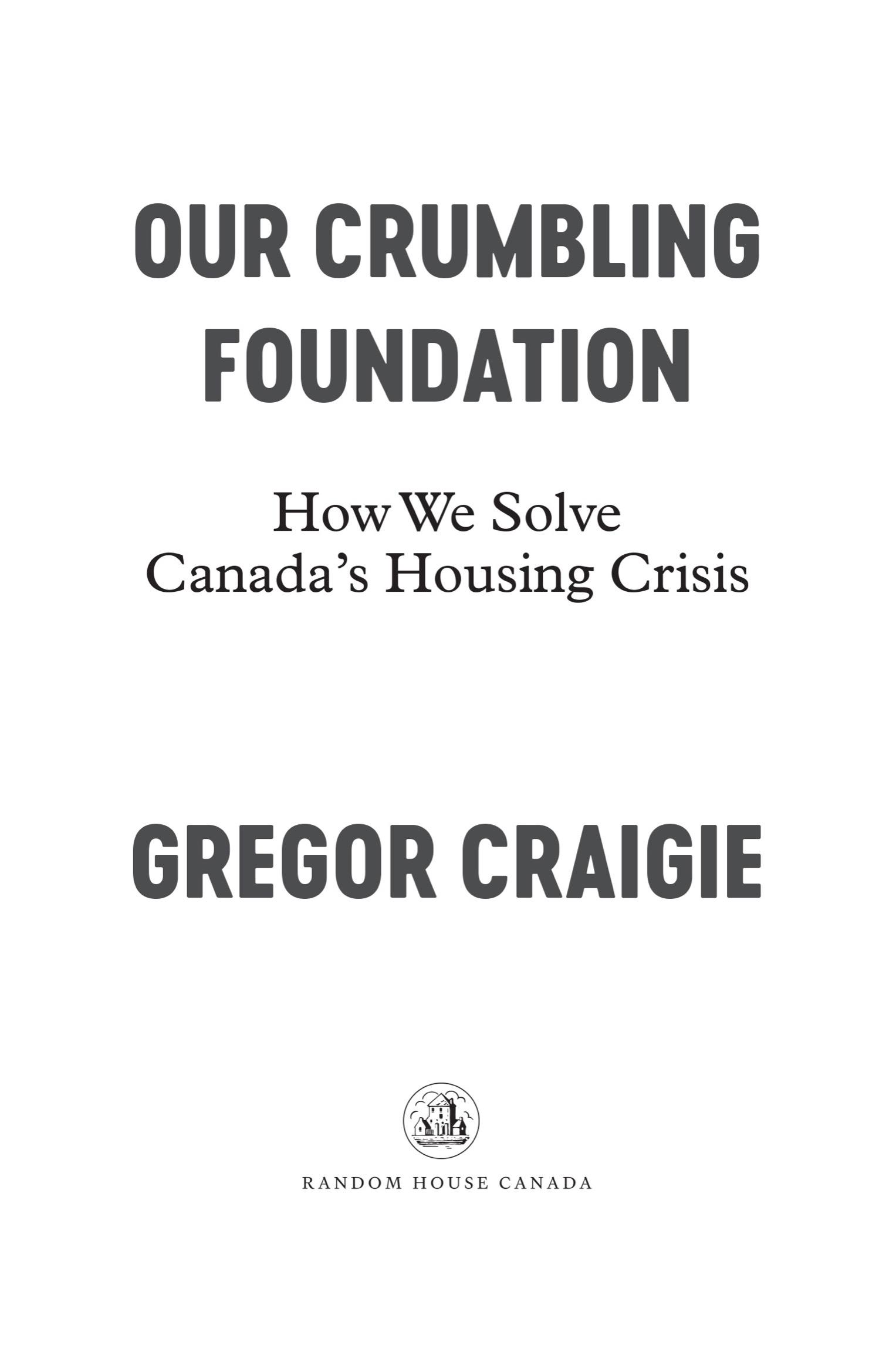https://ebookmass.com/product/our-crumbling-foundation-how-
Instant digital products (PDF, ePub, MOBI) ready for you
Download now and discover formats that fit your needs...
Pressure cooker: why home cooking won't solve our problems and what we can do about it Bowen
https://ebookmass.com/product/pressure-cooker-why-home-cooking-wontsolve-our-problems-and-what-we-can-do-about-it-bowen/
ebookmass.com
How We Heal Alexandra Elle
https://ebookmass.com/product/how-we-heal-alexandra-elle/
ebookmass.com
Innovation from Within: Redefining How Nonprofits Solve Problems Stephanie Berzin
https://ebookmass.com/product/innovation-from-within-redefining-hownonprofits-solve-problems-stephanie-berzin/
ebookmass.com
Dying by the Sword: The Militarization of US Foreign Policy Monica Duffy Toft
https://ebookmass.com/product/dying-by-the-sword-the-militarizationof-us-foreign-policy-monica-duffy-toft/
ebookmass.com
PRAISE FOR OUR CRUMBLING FOUNDATION
“Gregor Craigie blends clear writing, deep research and deeper compassion in this essential study of the housing crisis that affects us all —but especially society’s most vulnerable people. By applying a global lens to a national crisis, he highlights realistic ways to solve one of the most urgent problems of our time.”
Josh
O’Kane, author of Sideways: The City Google Couldn’t Buy
“In this insightful and accessible blueprint, Craigie navigates readers through the crisis of the Canadian housing landscape with national and international examples, that include both failures and innovative solutions. Written like a novel, each micro-chapter transports readers to the location of the story and into the lives of the characters. However, unlike fiction, this book provides copious facts, advice, and moments that tug at your heart and inspire action. While the alarm rings loudly, Craigie’s calm and expertly crafted narrative provides a beacon of hope. With compelling clarity, he empowers policy makers, and others, to embrace these transformative insights and breathe life into much-needed solutions. Don’t miss this essential read; the future of Canadian housing depends on it.”
Celina
Caesar-Chavannes,
author of
Can You Hear Me Now?
“To solve Canada’s housing crisis, Gregor Craigie roams the globe seeking answers in twenty disparate places.…Astonishingly, he finds individuals in every location willing to share intimate details of how they are coping with upheaval…He warns that Canada’s housing crisis is just beginning, offers a list of 37 measures to address the emerging nightmare, and, in ‘Craigie’s
ALSO BY GREGOR CRAIGIE
Non-fiction
On Borrowed Time: North America’s Next Big Quake
Fiction
Radio Jet Lag
For Young Readers
Why Humans Build Up: The Rise of Towers, Temples and Skyscrapers
This book is dedicated to everyone whose life is on hold because they cannot find a home of their own.
AUTHOR’S NOTE
����� ���� �� � ���� about housing, it inevitably deals with those who have none, which raises the question of what people without housing should be called. I use the words homeless and homelessness in this book, but I also use some of the other terms that are becoming more common, such as unhoused or people experiencing homelessness. While some housing advocates object to the word homeless, arguing it now has negative connotations, I have interviewed many people who are sleeping on the streets, and the vast majority of them have described themselves as homeless. As a result, I am comfortable using the term. When the Associated Press updated its style guide in 2020, it said “homeless is generally acceptable as an adjective to describe people without a fixed residence.” However, the guide urged AP writers to “avoid the dehumanizing collective noun the homeless, instead using constructions like homeless people, people without housing or people without homes.”
There is also the question of what exactly constitutes “housing.” In this book, I use the term broadly to cover home ownership, rentals, shared living arrangements with roommates, and even less traditional living arrangements, such as living in an RV. That’s not to say that everyone who lives in a recreational vehicle wants to live in one—indeed, many do not and I describe that in more than one chapter. However, housing can take many forms, and I use the term accordingly.
On currency—costs and prices are in Canadian dollars unless stated otherwise.
tripled, while the cost of everything else rose only 43 percent. The result is that homes are too expensive for many Canadians. On top of that, there just aren’t enough of them. The Canada Mortgage and Housing Corporation estimates that by the end of this decade Canada will need an extra 3.5 million homes. That’s on top of the more than 2.3 million new housing units already predicted to be built by then. But this crisis is about much more than just supply and demand. Single-family zoning, divestment from social housing, decades of low interest rates that encouraged the commodification of housing, and short-term vacation rentals have all contributed, along with many other factors. British Columbia and Toronto have recently eliminated most single-family zoning in an effort to increase the housing supply. But if Canada is going to make housing more affordable, or at least attainable, then it will need to make many more changes. That’s why I wrote this book. After reporting on this issue for more than twenty-five years, I want to see more people move into secure housing.
I’ve reported on housing and homelessness more times than I can remember. I’ve interviewed hundreds of people about this—renters, landlords, buyers, sellers, developers, real estate agents, homeless people, housing advocates, builders, building inspectors, market analysts, economists, municipal councillors, mayors, housing ministers, premiers, and prime ministers. It’s not that I’m obsessed by the issue of housing— though it has always interested me—so much as the fact that the issue has dominated life in British Columbia for as long as I’ve lived here. And it’s only got worse, both here and across a lot of the rest of the country. It took many years before it finally dawned on me exactly how big the problem is. It may seem counterintuitive, but this epiphany came to me not at work but at home, when my wife and I received our 2021 property assessment in the mail. The number seemed to scream out at me as soon as I ripped open the envelope: $1.3 million! Our 110-year-old, ramshackle wood frame house was worth a fortune. I felt a brief moment of jubilation, and even heard the Barenaked Ladies singing in my head. If I had a million dollars… I’d be rich. But my momentary elation at our new-found wealth on paper was eclipsed almost immediately by a sobering realization—there is no way
I could afford to buy my house today. I thought back seventeen years to when we bought our first house in Vancouver. I remembered the nagging suspicion that the $305,000 price tag would lead us to financial ruin. Little did we know it would be the best financial decision we’d ever make. Sure, we have another decade or so of mortgage payments in front of us, but we’re extremely lucky. Today, my journalist salary combined with my wife’s teacher salary simply wouldn’t be enough to buy that house, or the one I now call home. I thought of my young colleagues who won’t have the same opportunity I had, simply because they were born too late. Then I thought of my kids. How will they ever afford homes of their own? And where? If these sound like the middle-class concerns of someone who’s relatively fortunate, well, that’s because they are. I own a safe house in a beautiful city. It’s walking distance to schools, shops, and the beach. Everyone should be so lucky. And I know my kids will likely be able to rely on at least some financial help from their parents in the future—a factor that matters more and more these days, and only exacerbates intergenerational inequalities. But this book isn’t about me or my family. It’s about the millions of Canadians who are struggling with unaffordable housing, and the impact it is having on both them and the country as a whole.
This book tells the stories of Canadians who are suffering due to the lack of affordable housing in this country. It also profiles people in other countries who have benefited from changes that could work here. As a journalist, I’ve heard countless tales of struggle over the years. But in writing this book, I’ve heard many success stories too. They’ve convinced me that there is no single measure that will fix this problem. Instead, most or even all the solutions presented in this book will be needed. Of course, many measures have already been introduced in Canada, like co-op housing, which has been around for decades, and the recent two-year ban on non-Canadians buying residential properties here. But much more is needed.
It’s tempting to think we might just do nothing and wait this all out. While house prices smashed records during the first two years of the COVID19 pandemic, they started to drop in 2022. But make no mistake, housing is
the low rent. But in January 2021, a For Sale sign went up across the street that made them realize their bank account would never catch up with Vancouver.
Panned by architecture critics, the Vancouver Special proved popular with many new residents for its utilitarian design, which effectively maximized affordability and living space for extended family.
It was an old three-bedroom bungalow with no garage, listed at just under $1.3 million. The price tag did nothing to deter would-be buyers and
can’t get people into shelter,” he said during a panel discussion hosted by the Vancouver Sun in 2022. “We’re going to have people that are earning minimum wage who are not able to find rental or housing.”
Rennie may have been understating the problem, because the housing crisis affects more than just low-income earners, at least among young Vancouverites. Tom Davidoff sees that at the University of British Columbia. An associate professor who specializes in real estate and finance at UBC’s Sauder School of Business, he teaches a lot of students who are likely to make elite incomes after they graduate, but even they are anxious about housing in Vancouver. “When I ask a class of students if they’re worried about affording a good home, all of them raise their hands.” Prices have gone so high in Vancouver, Davidoff says, that “the luxury is having a housing unit at all.”
Yes, housing prices have shot up across the whole of Canada. But in Vancouver they’ve outpaced just about everywhere. In January 2001, the price for a detached house in Metro Vancouver was $345,260. By January 2021, when Martin and Nicole Chiu gave up on their dream of owning a home in their hometown, that price had jumped to $1,576,800. That’s an increase of more than 350 percent, while the average cost of all the items measured by Statistics Canada for the official inflation rate went up by just 43 percent over the same period. But there was worse to come. The prices just kept soaring, with the benchmark for a detached house finally peaking at $2,139,200 in April 2022—more than six times what it was in 2001. Even apartments cost a fortune in Vancouver, peaking at $844,700. That’s more than nine times the median annual household income in Metro Vancouver of roughly $90,000. More difficult to calculate is the number of young would-be buyers who gave up on their dream of owning a home, or the number of low-income renters evicted because their landlords decided to cash in on record-high prices.
To some extent, this is nothing new. Housing has been expensive in Vancouver for decades because newcomers arrive every year—both immigrants from overseas and migrants from the rest of Canada. Many are drawn by the allure of tranquil ocean currents, old-growth forests, and
snow-capped mountains floating above a green city that usually looks as though it’s just been washed. Some long-time residents simply shrug off the latest surreal numbers as the cost of living in paradise. Others view the prices as yet more proof the Vancouver housing market is totally disconnected from reality. Of course, many homeowners rejoice to see confirmation that their primary investment continues to grow in value. But others see trouble ahead—more people priced out of the market, more renovictions (the handy new term for the troubling trend of renters being evicted for renovations), and more homelessness.
Homeless encampments have a long history in Vancouver. During the Great Depression, the city became known as the Hobo Capital of Canada. In 1931 as many as twelve thousand people reached the end of the railway line without finding the jobs or fortunes that made them travel in the first place. Instead, they found themselves living in makeshift camps, christened “hobo jungles” by local newspapers. City officials eventually used a typhoid outbreak as the excuse to break up the camps. They sent the men, under threat of arrest, to so-called relief camps, where they provided cheap labour for federal projects like roads and airports. Before they were sent packing, many of those men slept in improvised shelters on the edge of the city dump, where Strathcona Park is now located, and where history was destined to repeat itself.
Martin and Nicole Chiu lived a fifteen-minute drive from Strathcona Park. By the time the couple started to think about leaving Vancouver, hundreds of people were sleeping on the site of the long-forgotten hobo jungle. Many had moved there the previous summer after being forced out of smaller encampments in other parks. Strathcona Park was estimated by some to be the biggest homeless encampment in Canada during the pandemic; it grew into a small city of tents and other makeshift structures. Its residents had to endure cold winter rains, at least one big dump of wet snow, considerable crime, and a fair bit of angry sentiment from some of their housed neighbours. With city parks turning into homeless camps and “tear-down” homes selling for millions of dollars, is it any wonder that housing is usually the main topic of conversation in Vancouver?
Even before he became premier in 2022, David Eby found himself in the unenviable position of having to move beyond talk and actually do something about the crisis. A human rights lawyer who once headed the BC Civil Liberties Association, Eby was named housing minister in 2020. In many ways it was a natural fit. Housing was one of the province’s most difficult and pressing issues, and Eby was one of the government’s most capable ministers. The lanky lawyer is quick on his feet in interviews. He was also worried about housing before many of his political colleagues came to the issue. That may be natural, given that Eby came of age just as Vancouver’s housing market was really starting to rise out of the reach of many in his generation. Furthermore, he was elected in Point Grey, one of Canada’s most expensive neighbourhoods. The leafy area of stately singlefamily homes, comfortable condos, cafés, and beaches has long been out of reach for most people of modest means. But the latest surging prices were shooting the local housing market into the stratosphere. At the peak of the market, in the spring of 2022, single-family houses in Point Grey ranged from a century-old two-bedroom house (listed as “a unique opportunity to kickstart the dream of owning land in one of Vancouver’s most desired neighbourhoods”) for $1.9 million all the way up to a 19,000-square-foot mansion priced at just under $39 million. The most expensive condominium was listed at $6.9 million, while the bottom end featured a handful of apartments in 1970s co-op buildings that were on the market for half a million dollars each.
In many ways, Vancouver’s housing market was a disaster, but Eby was worried it would get worse, even if prices were finally flattening out. He pointed to new statistics that suggested a perfect storm of housing unaffordability: the lowest number of homes for sale since records began, the highest in-migration of people to the province in thirty years, and a national survey that ranked British Columbia as the top pick for Canadians thinking of moving to a new province. Prices in his own neighbourhood were out of control, but that was nothing new. Now the contagion was spreading. In the Fraser Valley, east of Vancouver, the average price of a home had just increased by a jaw-dropping 42 percent in a single year. And
Vancouver. It took a decade for the developer, Westbank, and the city of Vancouver to settle on a final plan. The city decided to upzone the property —a process of increasing the allowable density on the site. When that was done, the developer was allowed to build more than 3 million square feet of residential space. But only 9 percent of that was set aside for social housing, and 4 percent for what the city considers affordable housing. In the end, 87 percent of the homes in this sprawling new development were priced beyond the financial means of most people in Vancouver who do not already own a home. Housing advocates were critical of Vancouver city councillors for not demanding a higher proportion of both social and affordable housing in the mix. But the deal is done, and luxury condos in the development have been marketed to overseas buyers in Dubai, Shanghai, and beyond. With construction costs soaring and investors lining up, the price of a 1,000-square-foot two-bedroom condo was predicted to be well above $2 million.
Andy Yan, the director of Simon Fraser University’s City Program, says developments like this one show what the marketplace is good at, and where it falls short. A registered professional planner, Yan was born and raised in Vancouver and has been studying housing affordability in the city for years. “Yes, Vancouver has a supply problem,” he says. “But governments have to understand that the market economy won’t provide housing for everybody.” Developers are good at building luxury homes, he points out, as well as many studio and one-bedroom condos. But they fall considerably short when it comes to affordable housing and middle-income housing of two and three bedrooms for families in some cities. So while municipal governments must make it easier for developers to build more private market housing, he says the federal government must also make major reinvestments in building public housing—something the federal Liberals all but abandoned when they slashed the budget in 1994. Until all levels of government do more, Yan predicts young families like Martin and Nicole Chiu will continue to leave Vancouver in droves.
In the end, the Chius did find their first home—in Calgary. They bought the three-bedroom townhome for $287,500. “We never thought we’d get to

